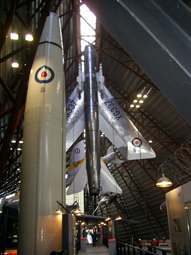Cold War Missiles
Below you will find a brief outline of the three main missiles to be based in the county. The full history of each missile can found by following the relevant link.
Bristol Bloodhound Missile

For a few days in October 1962, the world was poised on the brink of nuclear war. Tensions ran almost to breaking point, and for a few days it seemed that the unthinkable was about to happen. Across the UK, servicemen & women began to put their training to use, and the daily drills took on a far more serious air. At sites across the eastern counties of the UK, crews readied their Thor ICBMs and Bloodhound anti-aircraft missiles for action.
2012 marks the 50th anniversary of the Cuban missile crisis.
Did you serve on Thor or Bloodhound during the Cold war ? If so, the Aviation Heritage Lincolnshire 'Shouting the Odds' oral history project would love to hear from you.
You didn't have to be a high-ranking officer for the project to be interested - they'd like to hear from anyone with memories of working with the missiles during the Cold War.
Please contact Andy Lister-Tomlinson by email to share your memories.
Bristol Bloodhound Missile

The Bristol Bloodhound is a British surface-to-air missile developed during the 1950s as the UK's main air defence weapon, and was in large-scale service with the Royal Air Force and the forces of four other countries. The Bloodhound Mk. I entered service in December 1958 and the last Mk. II missile squadron stood down in July 1991, although Swiss examples remained operational until 1999.
If you would like to know more about the Bristol Bloodhound, take a look at our bloodhound information page.
Douglas PGM-17 Thor Missile

The Thor missile was the first operational ballistic missile in the arsenal of the United States, operated by the US Air Force. Thor was 65 feet (20m) in height and 8 feet (2.4m) in diameter.
Named after the Norse god of Thunder, it was deployed in the UK between 1959 and September 1963 as an Intermediate Range Ballistic Missile (IRBM) with thermonuclear warheads. It was later augmented in the U.S. IRBM arsenal by the Jupiter.
A large family of space launch vehicles (the Delta rockets) were derived from the Thor design. A modified version is still in use today as the first stage of the Delta II.
If you would like to know more about the Thor missile, then please see our Thor missile information page.
Avro Blue Steel

The Blue Steel missile was the result of a Ministry of Supply memorandum on the 5th November 1954 that predicted that by 1960 Soviet air defence's would make it dangerous for V bombers to attack with nuclear gravity bombs. The answer was for a rocket-powered, supersonic missile capable of carrying a large nuclear (or projected thermonuclear) warhead with a range of at least 50 miles). This would keep the bombers out of range of Soviet ground-based defence's installed around the target area, allowing the warhead to "dash" in at high speed.
There would have to be a balance between the size of the warhead and the need for it to be carried by any of the three V-bomber types in use, and that it should be able to reach Mach 3.
If you would like to know more about the Blue Steel missile, then please Blue Steel missile information page.
